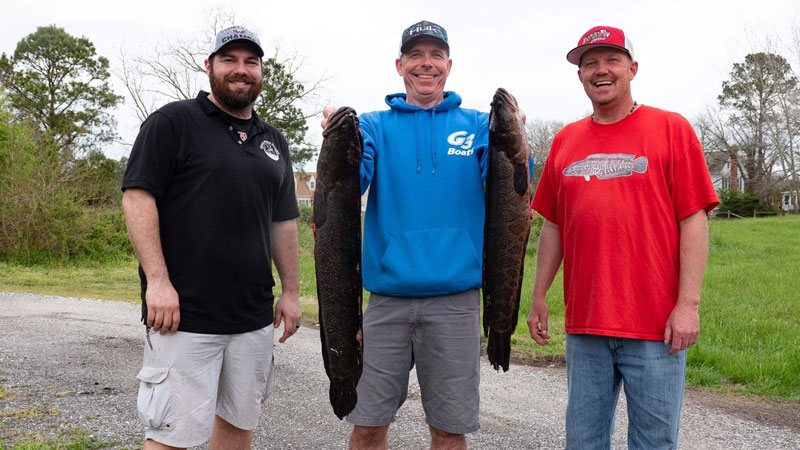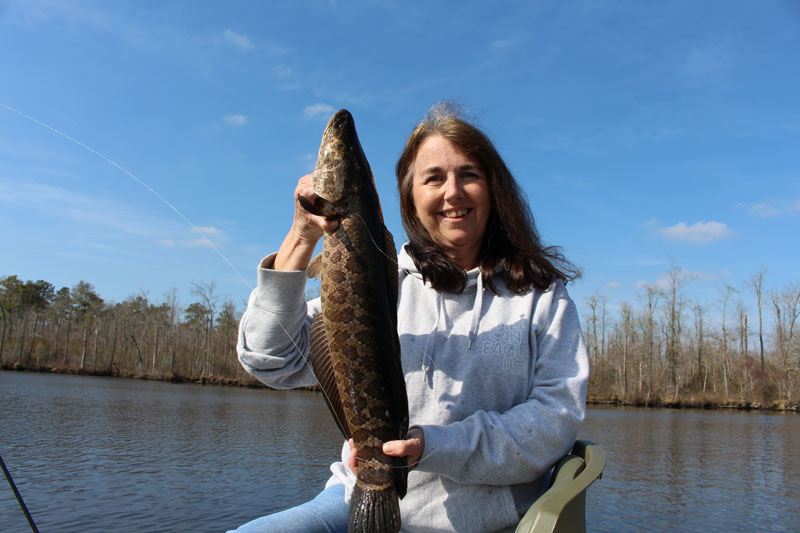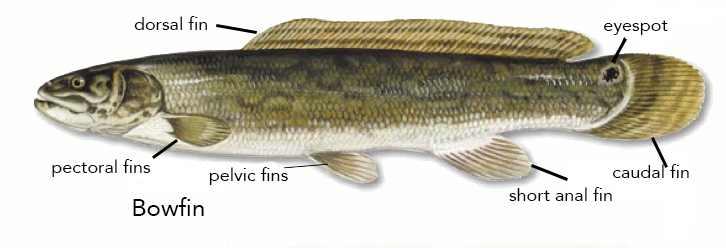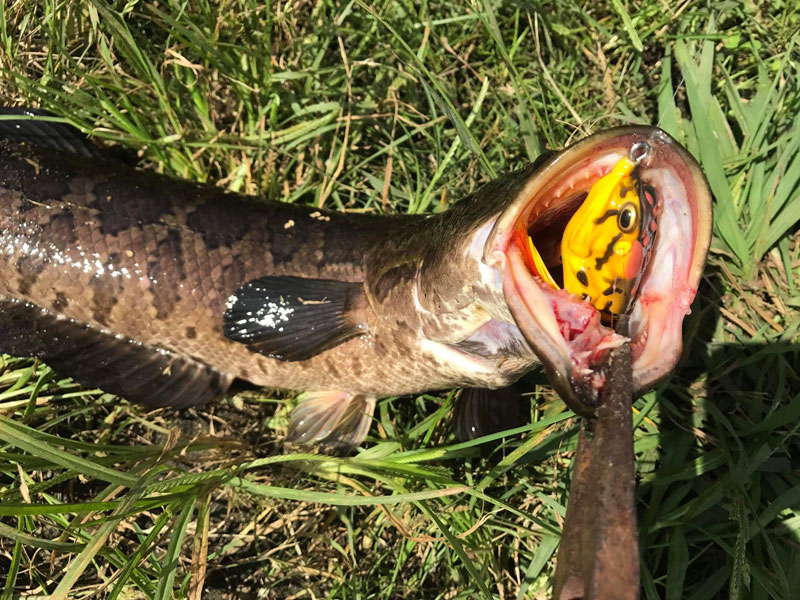The northern snakehead is a species of fish originally from Asia that has been classified as invasive, but has thrived in Mid-Atlantic areas such as the Blackwater complex, the Potomac River, and the Rappahannock River. Some areas were so desperate to prevent the spread of snakeheads that in 2012 if you posted a picture of yourself with a dead snakehead on Maryland’s Angler Log you could receive a $200 gift card. Snakeheads were first spotted in the region in 2002, when they were feared as an injurious species, and even today studies are being done to find out the effects of snakeheads in the environment and the best ways to combat them.

What are Snakehead Fish?
Snakeheads refer to the fish family Channidae which includes 21 species separated into two genera, Channa and Parachanna. The Channa incorporate 18 of those species and originate from Asia, while the Parachanna only contains three of the species and can be found in tropical Africa. Northern snakeheads are the variety commonly found in the Mid-Atlantic region. Snakeheads can also be referred to as Amur snakehead, eastern snakehead, and mudfish.
Snakeheads are freshwater fish but can handle low-salinity waters. They also have the ability to breathe air because of a labyrinth organ. Their ability to breathe air can allow snakeheads to live out of water for days at a time as long as their skin stays moist, which is one way they migrate and infest new areas.
Snakeheads reach sexual maturity at about age two and approximately 12 inches long. They can be identified with the characteristics listed below.
Northern Snakehead Identification:
- Long dorsal fin with soft rays
- Long anal fin with soft rays
- Pelvic fins located beneath the pectoral fins
- Longer lower jaw
- Dark irregular blotches
- Truncate tail
More Information on identifying Snakeheads can be found here in Snakehead Identification.


Record Northern Snakeheads
The Delaware record snakehead was caught by Bobby Smith in 2017 in the Nanticoke River. It tipped the scales at 12 pound, 12 ounces.
On May 24, 2018, the Maryland record for snakehead was broken by bow fisherman Andy Cox. In Mattawoman creek off the Potomac River, his fish hit 19.9 pounds and was over 35 inches in length.
Virginia doesn’t keep records for the northern snakehead. Interestingly, however, the IGFA world record all tackle snakehead was caught in Virginia waters. In May of 2018 Emanuel Tankersley caught a 19 pound, five ounce snakehead in Potomac Creek. It beats Cox’s larger fish as the world record because the IGFA does not recognize records for fish shot with a bow and arrow.
Where are Snakehead Fish Found?
In 2002, snakeheads were first identified in a pond in Crofton, MD, where they were soon dealt with by poisoning the water to prevent their spread. But in 2004 they were found in the Potomac River near Washington, DC. Northern snakeheads can now be found in 14 states, including Maryland, Virginia, and Delaware. Today, they’re found in various waterways throughout the area including both fresh and brackish water. They thrive in shallow waters, especially those with extremely thick vegetation and in low-oxygen areas where other predator fish usually don’t do well. In fact, in some places they can be caught from roadside ditches and canals.
If you’re looking to hunt snakeheads in Maryland, check out our article Destination: Snakeheads.
How to fish for Snakeheads
Snakeheads are big, ugly, and vicious, and often are hooked near heavy cover, so heavy line on a heavy rod with a stiff tip is in order. Think of fishing for them like fishing for bass, but bigger, meaner, and more likely to swim into snags when hooked up. Snakeheads can be caught on both lures and live bait. As a general rule of thumb lures tend to be more effective during the warmer months of the year and bait works best during the cooler months of the year. But this can vary quite a bit with weather patterns, and a sudden warm-up in the spring or fall can create great conditions for lure fishing when live bait worked best just days before. Conversely, a cold snap can weaken the bite on lures while live bait anglers suddenly do better.

Best Snakehead Fishing Lures
In warming conditions and especially during the summer, most snakehead anglers use lures. Catching snakeheads on topwater lures is particularly popular, since the angler gets to see spectacular explosions. Some top picks for lure fishing for snakeheads include:
- Topwater frogs
- Walk-the-dog lures
- Poppers
- Buzz-baits
- Chatterbaits
- Spinnerbaits

Best Snakehead Fishing Baits
In a nutshell, snakehead fish might eat anything that’s swimming or wiggling. They are opportunistic feeders and aren’t likely to reject something that’s alive and struggling. That said, the best snakehead fish baits include:
- Mummichog minnow (the bigger the better)
- Other small fish of any species
- Frogs
- Crayfish
Many snakehead anglers like to fish live baits under a bobber. Depending on water depth, a minnow or small fish can be suspended one to three feet down. Usually, the cooler the weather is, the deeper the bait is set.
Snakehead Fishing Regulations
All state regulations vary and should be consulted prior to fishing. However, in this case since snakeheads are invasive most state laws are basically the same: Snakeheads are to be killed and harvested when caught or immediately released into the water where it was caught. Transportation or possession of live snakeheads is illegal under federal law as well as many state laws, to prevent their spread. There is no closed season, no size limit, and no creel limits for snakeheads in most places. For fishing regulations in the Mid-Atlantic region, see:
Delaware freshwater fishing regulations
Maryland freshwater fishing regulations
Virginia freshwater fishing regulations
Although these fish are an invasive species, in some waterways they also thrive where previously there weren’t many sport fish for anglers to pursue. On top of that, they’re extremely good to eat and have very high quality firm, white meat. As a result, many people see them as a valid gamefish that has established itself in our waters and has a valid role to play in our fisheries. Read Fishing for Snakeheads: A New Look to gain that perspective.
-By Maya Rogalski
A top spot for snakehead fishing is on the Eastern Shore of Maryland, throughout the Blackwater and nearby rivers and creeks. Want to gain more insight into how, where, and when to catch them in the Blackwater river and marsh complex? Check out this video:
Watch our Live With Zach discussion about snakehead fishing from a kayak:









